For a child with a prosthetic limb, learning to use it effectively is just as important as receiving the limb itself. While prosthetics help restore mobility and independence, they do not automatically function like a natural limb. This is where occupational therapy plays a crucial role.
Occupational therapists (OTs) work with children to help them adapt to their prosthetic, develop motor skills, and gain confidence in daily activities. Through guided therapy, children learn to use their prosthetic limb for everyday tasks like eating, writing, dressing, and playing—things that seem small but make a huge difference in their independence and quality of life.
At Robobionics, we believe that a prosthetic should feel like a natural part of a child’s body. Occupational therapy ensures that children don’t just wear their prosthetic, but actually thrive with it. Let’s explore how occupational therapy helps children develop skills, build confidence, and live a full, active life.
1. What is Occupational Therapy and Why is it Important for Kids with Prosthetics?
Occupational therapy (OT) is a form of rehabilitation that helps people perform daily activities with ease. For children with prosthetics, OT focuses on teaching them how to use their artificial limb effectively in daily life.
Bridging the Gap Between Prosthetic Fitting and Everyday Use
When a child receives a prosthetic, they need time to learn how to control it, balance with it, and use it for different tasks. Unlike a natural limb, a prosthetic doesn’t move automatically—it requires practice, coordination, and adaptation.
An occupational therapist guides the child through this learning process, helping them understand how to grip objects, adjust their movements, and gain strength in their residual limb. Without proper therapy, many children struggle to use their prosthetic effectively, leading to frustration and even rejection of the limb.
Developing Muscle Strength and Control
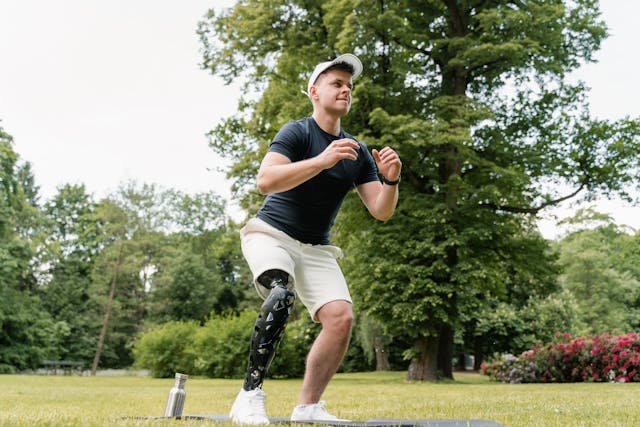
Using a prosthetic limb requires different muscles and movements than a natural limb. If a child is not used to these movements, they may find the prosthetic difficult or tiring to use. Occupational therapists design customized exercises that strengthen the muscles needed for prosthetic use.
For example, a child with an upper-limb prosthetic may practice gripping, lifting, and rotating objects, while a child with a lower-limb prosthetic may work on balance, walking, and coordination. These exercises help children gain control and confidence in using their new limb.
Making Everyday Activities Easier
Children with prosthetics need to learn how to perform daily tasks in a new way. Occupational therapy teaches them how to:
- Hold a pencil and write with a prosthetic hand.
- Tie shoelaces or fasten buttons with one hand.
- Use a fork and spoon with ease.
By helping children master these skills, occupational therapy allows them to become more independent, feel confident, and fully participate in school and social activities.
2. How Occupational Therapy Helps with Upper-Limb Prosthetics
Children with upper-limb prosthetics need to learn how to grip, hold, and manipulate objects with their artificial hand. This process can be challenging, but with occupational therapy, they can develop fine motor skills and gain full control of their prosthetic limb.
Teaching Children How to Grip and Release Objects
A prosthetic hand doesn’t have the same automatic response as a natural hand. Children must learn how to control their grip strength, release objects smoothly, and adjust their movements based on what they’re holding.
Occupational therapists use fun, interactive exercises like picking up blocks, squeezing sponges, or stacking cups to help children train their grip and hand control. Over time, these activities improve coordination, accuracy, and dexterity.
Improving Precision for Writing, Drawing, and School Activities
Many children worry about how they will write or draw with a prosthetic. Occupational therapy provides specialized training and adaptive techniques to help them use pens, crayons, and scissors effectively.
For example, children can practice:
- Holding a pencil with their prosthetic hand while stabilizing the paper with their other hand.
- Using adaptive grips or special writing tools to make writing easier.
- Learning alternative ways to hold and use school supplies.
These techniques allow children to fully participate in classroom activities without feeling left out.
Developing Two-Handed Coordination
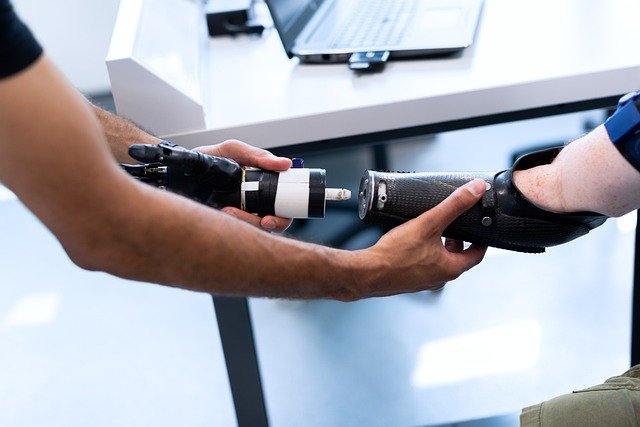
Children with one upper-limb prosthetic often need to relearn how to use both hands together. Occupational therapists teach them how to stabilize objects with their prosthetic hand while using their natural hand to complete tasks.
This skill is essential for activities like:
- Tying shoelaces or fastening buttons.
- Carrying trays or holding a book open.
- Playing musical instruments or video games.
Through guided therapy, children develop confidence and skill in using both hands effectively.
3. How Occupational Therapy Supports Lower-Limb Prosthetic Users
For children with lower-limb prosthetics, balance, mobility, and posture are key areas of focus in occupational therapy.
Teaching Stability and Balance
Walking with a prosthetic leg feels different from walking naturally. A child must learn how to shift their weight properly, maintain balance, and adjust their movements for different terrains.
Occupational therapists use stability exercises, such as:
- Standing on one leg for short periods to improve weight distribution.
- Practicing stepping over objects to develop coordination.
- Walking on different surfaces like grass, ramps, and stairs to build confidence.
These exercises help children walk smoothly and avoid falls or discomfort.
Improving Mobility for Sports and Play
Children love to run, jump, and play. Occupational therapy ensures that a prosthetic doesn’t stop them from enjoying their favorite activities.
Therapists introduce fun movement exercises, such as:
- Jumping on soft mats to build leg strength.
- Practicing running drills to improve speed and agility.
- Climbing and balancing activities to develop muscle control.
By making therapy engaging, children become more active and confident in using their prosthetic in real-world situations.
Ensuring Comfort and Reducing Strain
An improperly used lower-limb prosthetic can cause pain, muscle strain, and discomfort. Occupational therapy helps children:
- Adjust their posture to reduce pressure on their residual limb.
- Strengthen supporting muscles to prevent overuse injuries.
- Practice correct walking techniques to improve long-term mobility.
Through proper training, children learn to move with ease, without discomfort or limitations.
4. The Emotional and Social Benefits of Occupational Therapy
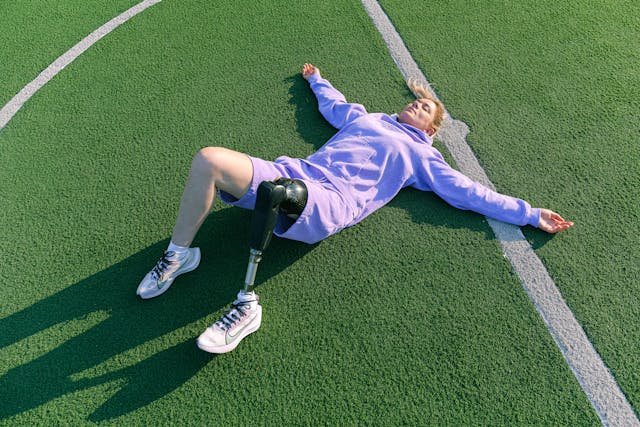
Beyond physical skills, occupational therapy helps children develop confidence, independence, and a positive attitude toward their prosthetic limb.
Building Self-Esteem and Reducing Frustration
Learning to use a prosthetic can feel frustrating at times. Children may compare themselves to others or struggle with tasks that used to be easy. Occupational therapists provide emotional support, encouragement, and motivation to help children stay positive.
When children see their progress, they feel more confident and proud of what they can do.
Encouraging Social Participation
Children with prosthetics may feel self-conscious or hesitant to join group activities. Occupational therapy includes group play, social skill-building, and peer interaction, helping children feel more comfortable and included.
Empowering Children to Live Independently
The ultimate goal of occupational therapy is to help children live as independently as possible. By teaching them practical life skills, therapy ensures that a prosthetic limb never becomes a barrier to their dreams and ambitions.
5. Supporting Occupational Therapy at Home
The best way to help your child succeed with their prosthetic is to continue practicing the skills they learn in therapy at home.
Making Practice Part of Everyday Life
Children learn best through repetition and real-life application. Instead of setting aside separate “practice time,” parents can integrate therapy exercises into daily routines.
For example:
- Encourage your child to use their prosthetic hand for eating, brushing teeth, or turning door handles.
- Let them practice balance and walking exercises while playing games or doing household tasks.
- Turn fine motor activities into fun challenges, like stacking blocks, threading beads, or pouring drinks.
By reinforcing therapy skills in natural settings, children develop confidence and muscle memory without feeling like they are doing “work.”
Creating a Supportive Home Environment
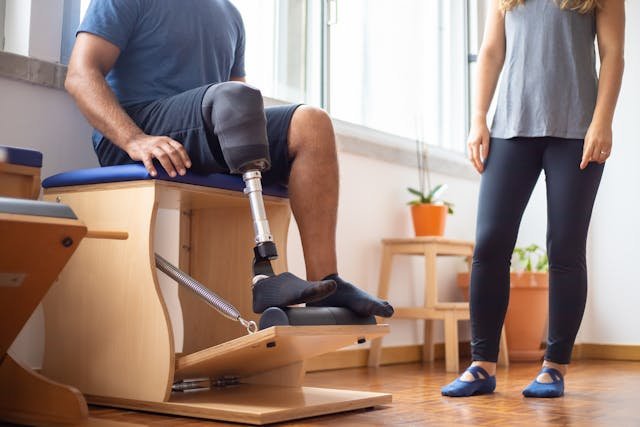
Simple changes at home can make a big difference in a child’s ability to use their prosthetic limb comfortably. Parents can:
- Use adaptive tools like special grips for pencils, utensils, and cups.
- Ensure furniture is arranged for easy movement, especially for children with lower-limb prosthetics.
- Encourage independence by placing frequently used items within reach so children can access them without assistance.
These small adaptations help children develop self-reliance and confidence in their abilities.
Celebrating Small Wins and Milestones
Learning to use a prosthetic takes patience and persistence. Parents should celebrate every small achievement, whether it’s successfully buttoning a shirt, using scissors, or walking without support.
Offering praise, encouragement, and rewards makes therapy feel motivating and fun, reinforcing a child’s positive attitude toward their prosthetic.
6. Helping Children with Prosthetics at School
A child’s school environment plays a big role in their ability to use their prosthetic confidently and participate in activities. Teachers, classmates, and school staff should be aware of how to support the child’s needs while encouraging independence.
Communicating with Teachers and School Staff
Parents should work closely with teachers to:
- Educate them about their child’s prosthetic limb and any specific adaptations needed.
- Discuss therapy progress so teachers understand what the child is capable of.
- Ensure accessibility in the classroom—such as adaptive desks, supportive seating, or modified sports equipment.
When teachers understand how to support a child with a prosthetic, they can help make school a comfortable and inclusive space.
Encouraging Full Participation in Activities
Children with prosthetics should never feel left out of sports, playtime, or classroom activities. If a child struggles with certain tasks, minor adjustments—like using a different grip, choosing a comfortable chair, or modifying a sports technique—can help them fully engage.
Occupational therapists often work with schools to recommend adaptive tools and modifications that allow children to participate equally in learning and play.
Building Confidence in Social Settings
Children with prosthetics may feel self-conscious or different from their classmates. Parents and teachers can help by:
- Encouraging open conversations so classmates understand the prosthetic and see it as normal.
- Helping the child practice how to answer questions confidently if others ask about their limb.
- Pairing them with supportive friends who make them feel included in group activities.
When children feel accepted and supported at school, they are more likely to embrace their prosthetic with confidence.
7. Emotional Support and Psychological Well-Being
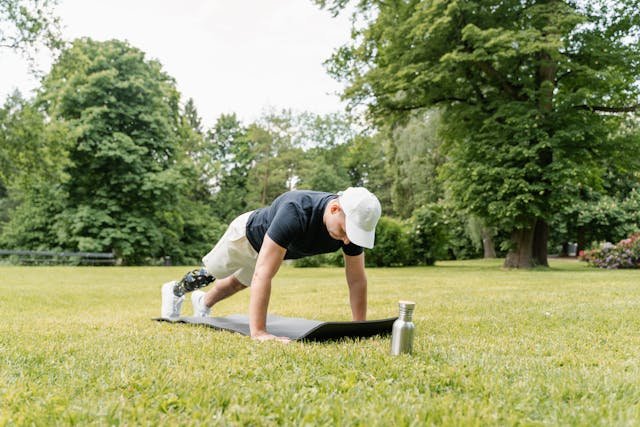
Beyond physical skills, children with prosthetics need emotional support to develop a healthy self-image and positive mindset.
Helping Children Feel Proud of Their Prosthetic
A child’s attitude toward their prosthetic is shaped by how their family and friends react to it. Parents should:
- Talk about the prosthetic in a positive way—it’s not something to hide, but something that helps them do amazing things.
- Let them personalize it with colors, stickers, or fun designs that make it feel special.
- Encourage them to share their story and see their prosthetic as a unique part of who they are.
When children see their prosthetic as something to be proud of, they are more likely to use it with confidence.
Addressing Frustration and Emotional Challenges
Adjusting to a prosthetic can be frustrating. Children may struggle with tasks that were once easy, feel tired from using their new limb, or face moments of discouragement. Parents can help by:
- Acknowledging their feelings and reminding them that frustration is normal.
- Encouraging patience and persistence—every new skill takes time to master.
- Celebrating progress, even when it’s small, to keep them motivated.
If a child is experiencing ongoing emotional distress, occupational therapy can include counseling and psychological support to help them navigate their feelings in a healthy way.
Connecting with Other Children Who Use Prosthetics
Meeting other children with prosthetics can be incredibly empowering. It shows them they are not alone, helps them see role models who have succeeded, and gives them a community of support.
Parents can explore:
- Peer support groups for kids with prosthetics.
- Sports teams or hobby groups for children with limb differences.
- Events and workshops where kids can share experiences and make friends.
A strong support network helps children feel confident and accepted, making it easier for them to embrace life with their prosthetic.
8. The Future of Occupational Therapy and Prosthetics
Prosthetic technology and rehabilitation techniques are constantly evolving, making it easier for children to adapt to their prosthetic limbs and lead fully active lives.
Advancements in Smart Prosthetics and AI
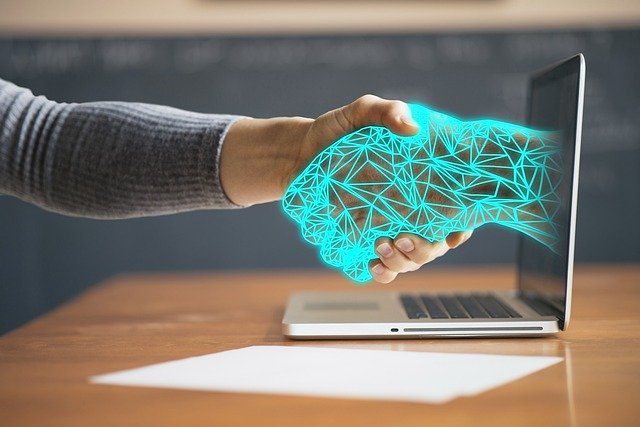
New developments in bionic and myoelectric prosthetics are allowing children to control their prosthetic limbs using muscle signals. As these technologies advance, occupational therapy will play a crucial role in teaching children how to operate these intelligent prosthetics with precision and ease.
For example, in the near future, therapy may include:
- Training children to use brain-machine interfaces to control prosthetic hands effortlessly.
- Using virtual reality (VR) simulations to improve muscle coordination and fine motor skills.
- Developing AI-driven rehabilitation programs that customize exercises based on the child’s progress.
These innovations will make prosthetics more intuitive and natural to use, reducing the learning curve and giving children even greater control over their movements.
More Accessible and Affordable Therapy Options
As awareness of occupational therapy’s importance grows, more programs are being developed to make it accessible to all families, regardless of location or financial status.
At Robobionics, we support home-based rehabilitation solutions, allowing children to practice skills through gamified training exercises and virtual therapy sessions. These tools make therapy more engaging and convenient, ensuring that children get consistent practice, even outside of clinical settings.
A Greater Focus on Social Inclusion
More schools, sports teams, and activity groups are becoming disability-inclusive, helping children with prosthetics integrate seamlessly into daily life. Occupational therapy will continue to play a key role in preparing children for social interactions, making sure they have the skills and confidence to engage in group activities, make friends, and navigate public spaces without hesitation.
With ongoing advancements in therapy techniques, prosthetic design, and community support, the future is bright for children with prosthetic limbs.
9. The Role of Parents, Caregivers, and Support Networks
While occupational therapists provide professional training, parents, caregivers, teachers, and friends play an equally important role in a child’s adaptation process.
How Parents Can Encourage Progress at Home
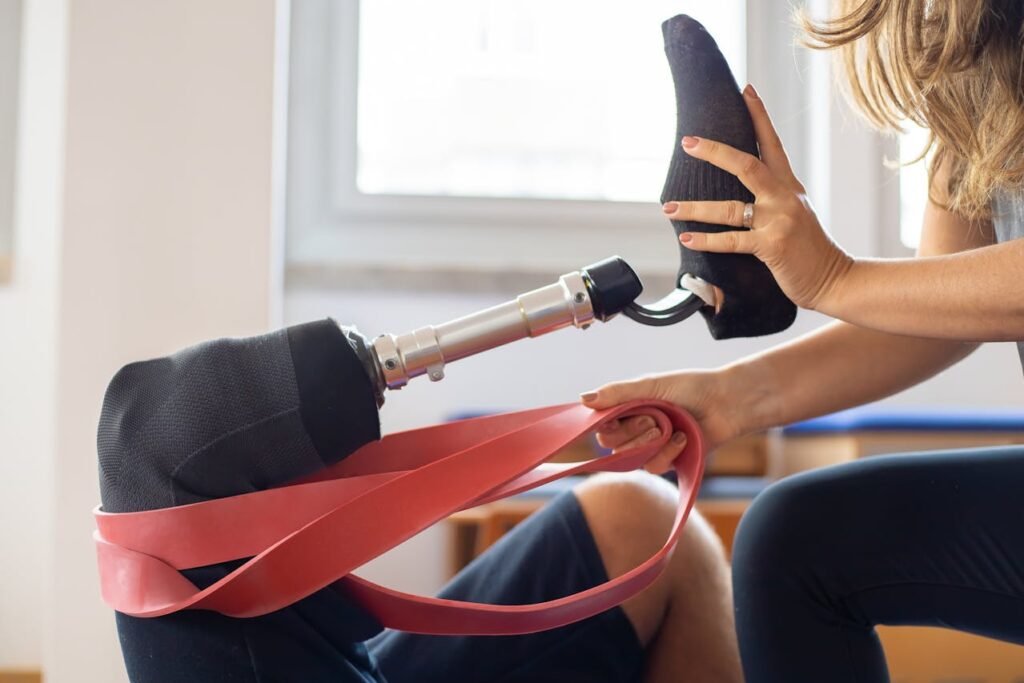
Parents are the biggest source of encouragement for children adapting to a prosthetic limb. Here’s how they can help:
- Reinforce therapy exercises through daily routines, making skill-building feel natural.
- Celebrate achievements, no matter how small, to boost confidence and motivation.
- Encourage their child to take on challenges, helping them see obstacles as opportunities for growth.
A positive and patient approach makes all the difference in how quickly and smoothly a child adjusts to their prosthetic.
The Importance of Peer Support
Children often feel more confident when they meet others who share similar experiences. Parents can:
- Connect with other families through support groups, workshops, or online communities.
- Encourage friendships with children who also use prosthetics, helping them feel understood and accepted.
- Expose them to inspiring role models, such as athletes, musicians, or artists with prosthetics, to show them that their potential is limitless.
A strong support system empowers children to see their prosthetic as a strength, not a limitation.
Working with Schools and Teachers for Inclusion
Collaboration with teachers ensures that children with prosthetics feel included and supported in their learning environment. Schools should:
- Provide adaptive learning tools if necessary.
- Encourage full participation in sports, arts, and extracurricular activities.
- Create an environment where all children understand and respect differences.
When schools actively promote inclusion and accessibility, children with prosthetics feel confident, comfortable, and ready to take on the world.
10. A Message to Parents: Every Step Counts
Helping your child adapt to a prosthetic limb is not always easy, but every small step forward is a victory. There will be challenges, but there will also be incredible moments of growth, independence, and success.
As a parent, the best thing you can do is:
💙 Be patient—learning takes time.
💙 Be encouraging—your support builds their confidence.
💙 Be involved—help reinforce therapy techniques at home.
At Robobionics, we are here to support you and your child every step of the way. Whether it’s choosing the right prosthetic, finding the best therapy solutions, or providing long-term care and adjustments, we are dedicated to helping your child live their best life.
Final Thoughts: The Power of Occupational Therapy in a Child’s Journey
A prosthetic limb is only as useful as the skills and confidence a child has to use it. Occupational therapy bridges the gap between receiving a prosthetic and truly thriving with it.
At Robobionics, we believe in a complete approach to prosthetic care, which includes occupational therapy, rehabilitation, and long-term support.
🚀 Want to help your child adapt to their prosthetic faster? Book a free consultation with our experts today!
💡 Have questions about rehabilitation? Contact us now and let’s find the best solutions for your child’s journey!



